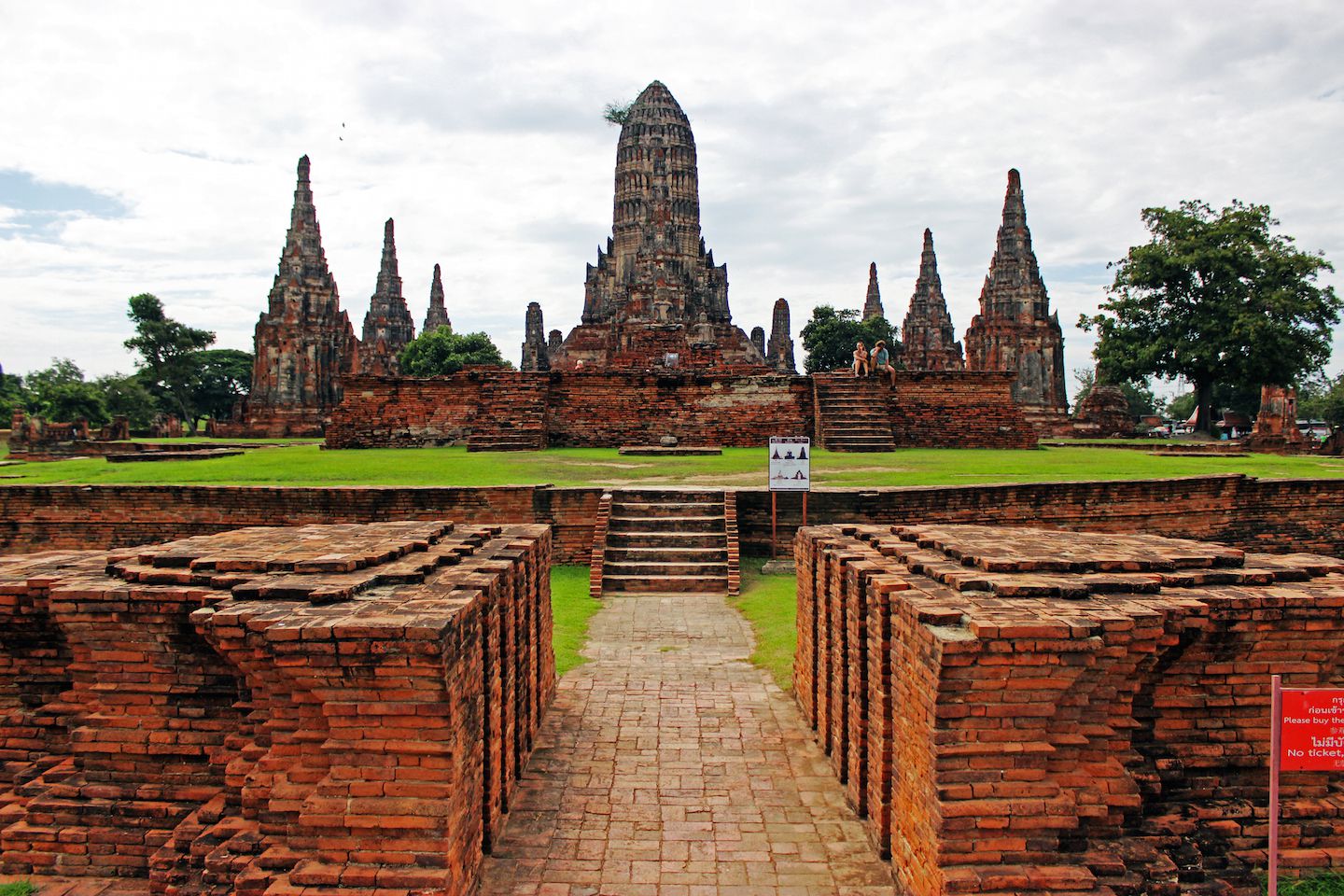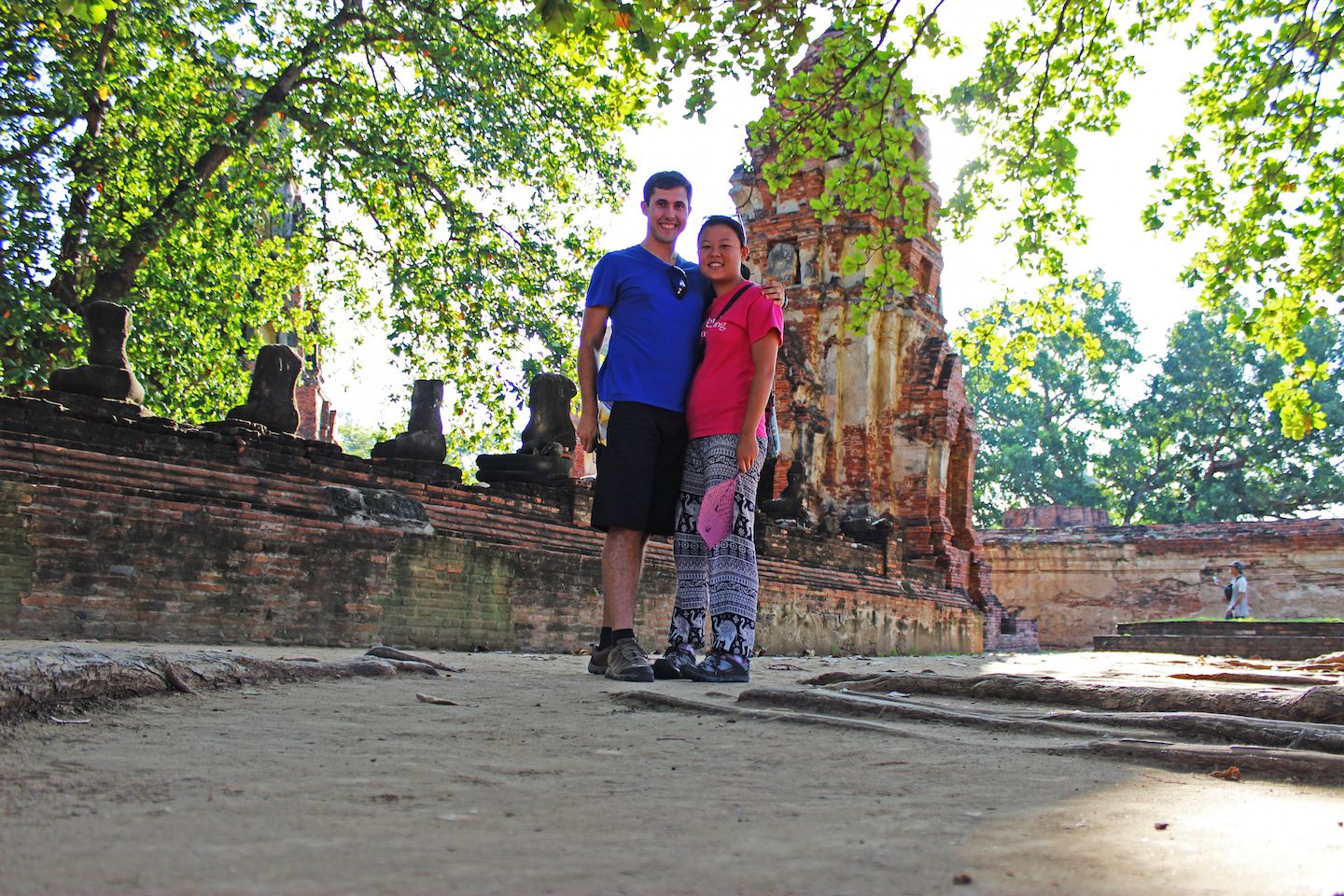Just an hour north of Bangkok is Thailand’s old capital of Ayutthaya. The Kingdom of Ayutthaya was founded in 1350 by King Ramathibodi I and by 1700 it was the world’s largest and most prosperous city with over one million inhabitants. The kingdom was destroyed by the Burmese in 1767 and left behind several hundreds of temples that still stand today. The historical city of Ayuttaya is actually on an island formed by three different rivers and considered a UNESCO World Heritage Site.
Wat Phutthai Sawan
With several golden Buddha statues surrounding the main white prang (Khmer-style tower), Wat Phutthai Sawan was built by King Ramathibodi I and contained his statue. The monastery was still active – we saw monks worshipping the Buddha statues inside. While the main white prang was in Khmer-style, its white color and details made it look different than the countless we saw at Angkor.

Several modern buildings were built around it, including another temple with three big golden Buddha statues.

Wat Chaiwatthanaram
One of the most beautiful and well-known temples in Ayutthaya, Wat Chaiwatthanaram occupied a large area of land. This royal Buddhist temple had traces of Khmer architecture, but with some Thai additions to it. The chedis on top of the towers gave the temple a very characteristic outline against the sky. Its five main towers, as usual, symbolize the five peaks of Mount Meru.

The temple was built using bricks and mortar, which wasn’t common in Khmer-style temples and gave us a sense of a more modern construction. Besides the towers, most of the temple was in ruins, with several destroyed Buddha statues and no roofs on any of the outer galleries.

Wat Chaiwatthanaram extended all the way to the river on the east side. We didn’t go, but I imagine the view of the temple from the other side of the river must be nice. The entire temple had a very calm and serene feel, and it was nice to just spend some time here appreciating the ruins of what was once a temple of the powerful Ayutthaya kingdom.

Wat Phu Khao Thong
The massive, 50-meter tall white chedi of Wat Phu Khao Thong could already be seen as we approached the temple from afar. Stairs led the way up the tower on all four sides of the pyramidal base. The view from the top was impressive, especially since most of the city of Ayutthaya is flat and by the river.

One curious thing we noticed only once we left the temple was that Wat Phu Khao Thong was actually slanted. The top tower was definitely leaning. We joked that it was like the Thai version of the Leaning Tower of Pisa.

Wat Phra Si Sanphet
Three white chedis dominated the grounds of Wat Phra Si Sanphet. With the ruins of the temple surrounding them, I can only imagine what it was like in its prime. The white chedis looked exactly like older versions of the many golden chedis characteristic to Thailand. Thus it was the first temple that looked very Thai, as opposed to Khmer-style. Following the trend here, the temple was built entirely with bricks and mortar.

Wat Mahathat
Wat Mahathat was home to one of the most famous and iconic shots of Ayutthaya. The head of a stone Buddha statue was in a tree – the tree roots grew around the perfectly preserved face. When taking a photo with the statue, it was customary to squat as one should not be standing over Buddha.

The rest of Wat Mahathat was in ruins – the Buddha in the tree was definitely the highlight.

We can’t deny that after a day of temples in Ayutthaya and what has been weeks of temple-centric attractions, it was getting harder and harder to work up the same enthusiasm and excitement we had in the beginning. Nonetheless, there was always something unique about each temple and Ayutthaya was such a significant part of Thai history that it deserves a visit. We continue the trek through historical Thai kingdoms with Sukhothai next.
For more pictures from Ayutthaya, please visit the gallery!

